

6 Best Trailerable Trimarans For Bluewater and Coastal Sailing

As an Amazon Associate, we earn from qualifying purchases. We may also earn commissions if you purchase products from other retailers after clicking on a link from our site.
Having a boat costs a lot of money, even when you are not using it, marina fees, etc. And once it is in the water most sailors never go very far from their “home marina” and sailing will be somewhat restricted. However, what if you could fold your trimaran and put it on a trailer, store it at your house, and go to a new sailing spot the next time?
Here are 6 of the best trailerable trimaran:
- The Dragonfly series
- Corsair Series
- Windrider 17
Choosing the best trailerable trimaran (a multi-hull with three “hulls”) will depend on crucial factors like speed, durability, design, and ease of transportation. This article is here to help you get started with your research and hopefully help you on the way towards your dream boat!
Table of Contents
Cruising Trimarans That Can Be Transported
Cruising boats are made for multiday sailing either on the coast of your favorite sailing area or full-out blue-water ocean crossings. Extended living should be a priority in these designs.
1. The Dragonfly 25 and 28 (Dragon Fly Series)
Dragonfly is in the business of making the “best foldable trimarans on the planet” many would agree with this statement. Dragonfly is known for its commitment to easy trailering and ease of use, shown in designs for the Dragonfly 25 and Dragonfly 28.
The “Swing Wing” system on the linchpins is one of the key features of the dragonfly series. The system’s application makes it possible for the trimaran to narrow its beam as much as 50%.
Attesting to its Scandinavian manufacturing, most parts of the trimaran are made in-house. This guarantees quality and ensures that all used parts are above standard.
You don’t need to look further than the Dragonfly 25. Its centerboard slightly offset to port. Extra space is created in the main hull’s interior with a trunk buried under a settee. Performance-wise, the low drag and narrow hull shape allow the boat to reach blistering speeds.
Dragonfly 28 In Numbers
- Length: 8.75m
- Beam folded: 2.54m
- Max crew: 5-7 people
- Max Speed: 22+knots
Dragonfly 25 In Numbers
- Length: 7.65m
- Beam folded: 2.30m
- Max crew: 4-6 people
- Max Speed: 21+knots
2. Farrier F-22
New Zealand enters the trimaran manufacturing race with this premium sea goer. The vessel comes in two different versions: a performance variation with more horsepower and a full cabin cruising version.
Compared to the dragon series the F-22 has the biggest allowance for space.
The F-22 is known for being one of the easiest trimarans to fold and load.
The sports version of the F-22 has some really good performance to offer. It has an aggressive spirit: you can mount a sail while leaving plenty of space for the boat’s fine entry and flared forward sections. The build quality is also topnotch—a lasting memorial to a principle that Ian Farrier always worked by: excellence.
Farrier F-22 In Numbers
- Length: 7.0m
- Beam folded: 2.5m
- Max crew: 3-5 people
- Max Speed: 20+knots
3. Corsair Series
This boat series has an exciting history. Farrier created it to promote his trailerable tri concept. However, the series is now independent with a top-class vehicle to its name.
The Corsair 760 is listed as providing some of the best performance and safety benefits to sailors.
Building off the spirit of excellence of the founder, the Corsair 760 has created a boat with comfort and racing potential. The boat can be tricky to handle at first, but it will be a breeze once you get the hang of it.
It is also worth noting that the corsair 37 is the largest trailerable trimaran on the market today.
Daysail Trimarans That Can Be Transported
Boats that are made for dayssailing are usually smaller, cheaper and more easily handled. They are perfect for those looking to enjoy a full day on the water in calm weather, but are usually less suitable for multiday events or rough sea sailing.
4. The Astus Models (20ft, 22.5ft, and 24ft)
If you’re looking for something small but still capable of doing day sailing, this 22.5-foot trimaran is for you. Built for speed and maneuverability, the Astus 22.5 has optional foils to optimize speed.
The modern design, coupled with the spacious interior, can fit up to four beds. Accordingly, this trimaran is suited for family outings.
The Astus brand specializes in transportable trimarans, worth noting is that some models need a specific trailer whilst the smaller boats use a standard trailer.
5. Weta 14.5
The 2019 Weta trimaran is a 14.5-foot (4.4-meter) trimaran featuring a carbon frame, centerboard, rudder foil, and rudder shock. The hull is made from fiberglass and foam. The Weta is built for strength and speed based on these lightweight materials.
The 2019 Weta trimaran is easy to sail and is worth considering whether you want to take a quiet sail, race with your friends, or take kids to a sailing lesson. It has a simple design and is easy to set up independently.
The small size makes it more suitable for daysailing in good weather rather than multiday cruising, although more experienced sailors will of course push the limits of this boat.
6. WindRider 17
The 17.4-foot (5.3-meter) WindRider 17 is one of the more versatile trimarans in the market. It packs high performance for a low cost. This trimaran has a light rotating mast to boost performance, and a full-battened mainsail optimizes visibility.
This sailboat is made from rotomolded polyethylene, which is more durable than fiberglass and demands less maintenance.
The WindRider 17 has a comfortable interior and can fit six adults. This is an ideal choice for social sailing for a couple or a family and friends. It’s easy to ride, and a shallow draft allows easy maneuverability.
What’s the Largest Trailerable Trimaran?
The largest trailerable trimaran is the Corsair 37 , this multihull is built for single-handed cruising while still maintaining the ability to comfortably seat 6 people.
The Corsair 37 provides comfort, speed, and safety. It also contains just enough space to accommodate amenities like a propane stove, a sink, and other equipment.
The vessel is designed to be a performance cruiser. It features an aluminum rotating wing mast, carbon fiber bowsprit, and premium deck hardware. The corsair can still cut through the water with ease despite its size, putting the wind in your sails.
What Is a Catamaran?
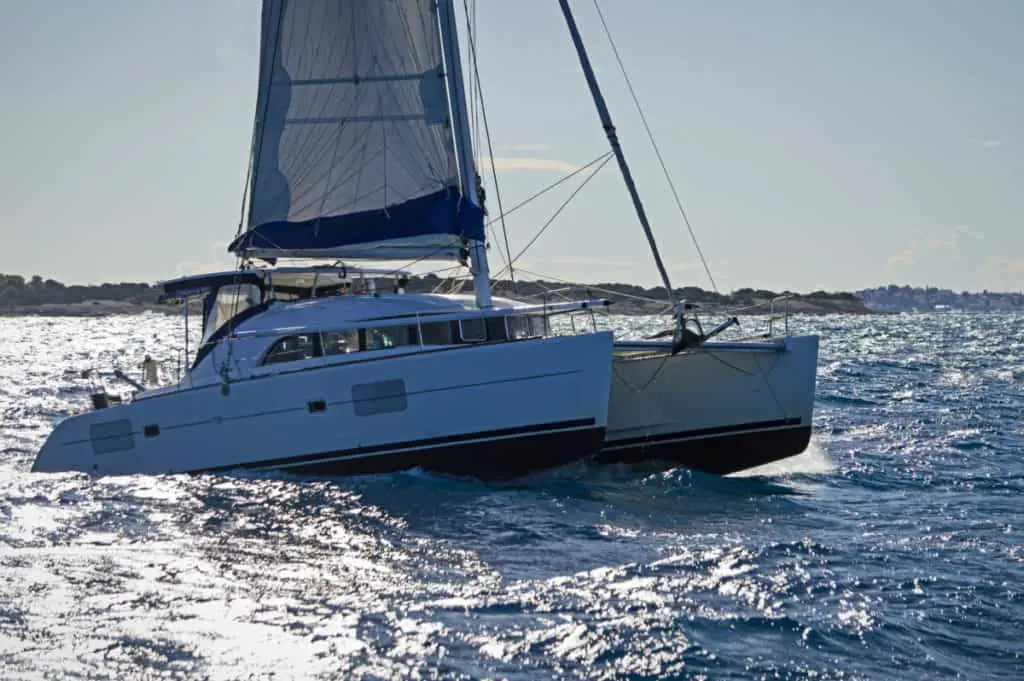
A catamaran is a boat with two hulls (a trimaran has three) connected by a bridge deck. Catamarans usually offer more space than both monohulls and trimarans of the same length. The catamaran is usually somewhat slower than a trimaran but faster than a monohull. They are usually made of fiberglass or carbon fiber.
Catamarans come in all shapes and sizes. You can find straightforward sailing catamarans, perfect for those who are only starting their sailing journey. Larger sailing catamarans have become extremely popular for long-distance sailing.
There are also power catamarans, they have huge diesel-powered engines (sometimes electric) and no sails. Also called “power cats”, these boats can reach 30+kts.
Can a Trimaran Be Trailerable?
As discussed above, some trimarans are possible to put on a trailer and move to another sailing area or to be stored at home. This is usually not possible with catamarans but is sometimes possible with the trimarans that are fitted with foldable amas (the two outer “floats” or “hulls”).
Some trimarans can be trailerable, this is mainly due to the ability to drastically decrease the vessels beam, sometimes as much as 50%. This allows the trailer plus trimaran to be below the legal requirements of the road.
Final Thoughts
It has proven difficult to beat the trimaran in terms of speed. Through the ages, this type of vessel has proven to be immensely enjoyable in all kinds of sailing activities. These can range from sea adventures to waterborne relaxation in your free time.
Trimarans come in various types, foldable, for cruising or racing, etc. However, there is a common factor: many of the small ones are trailerable. This makes them easier to move than most other types of boats.
Owner of CatamaranFreedom.com. A minimalist that has lived in a caravan in Sweden, 35ft Monohull in the Bahamas, and right now in his self-built Van. He just started the next adventure, to circumnavigate the world on a Catamaran!
Leave a Reply Cancel reply
Your email address will not be published. Required fields are marked *
Save my name and email in this browser for the next time I comment.
Recent Posts
Must-Have Boat Gear for Catamaran Sailors!
Sailing is probably the most gear-intensive activity I've ever done; there are so many decisions to be made about what gear to buy now, for tomorrow, and what to definitely never buy. The gear on...
What Kind of Boat Is The Best Liveaboard? Trawler, Monohull, or ...?
Living in a boat can be a thrilling, once-in-a-lifetime experience; however, knowing how to choose the right vessel to sustain the lifestyle you want to achieve can be crucial in making the most out...

Free Shipping in the US on Orders $75+
- 1-888-609-2827

Item added to your cart
The complete list of trimarans.
There is no single trimaran that is best for everyone. Where some prefer luxury cruisers for long trips with family and friends, others might opt for a high performance racing tri for thrilling rides at breakneck speeds. With the recent spike in trimaran popularity, these days there is a perfect tri for every sailor. So to help prospective trimaran owners decide which boat is just right for them, we here at WindRider have put together a comprehensive list of the best trimarans on the market today! Read through for simple at-a-glance trimaran comparisons of boats both big and small, exhilarating and relaxing, and for all price points.
Jump to a specific sailing trimaran: Neel Weta Corsair WindRider Dragonfly Catri Astus Hobie Sea Pearl Farrier Sea Cart Multi 23 Triak SeaRail Warren Lightcraft Diam Radikal Challenger

Known for their award-winning luxury trimarans, NEEL is based in La Rochelle, the capital city of sailing in France. NEEL trimarans are built for fast cruising with an average cruising speed of about 10 knots, and are even configured to facilitate that sustained speed under motor propulsion. The NEEL 45 was notably named Cruising World’s Most Innovative Vessel in 2013, and by all accounts is an easy-to-sail, high performance boat that is just plain fun.
At a glance:
Models: NEEL 45, 65
Length: 45’ – 65’
Cost: $$$$$
Use: Luxury cruiser

A fan favorite, Weta trimarans are fast, stable, and remarkably easy to rig. This single-sailor tri has a capacity of up to three, and the ease with which it can be transported and stored makes this a great, versatile boat for beginners. The Weta was named Sailing World’s 2010 Boat of the Year, and one ride is enough to know why: simply put, the Weta is an absolute ton of fun to sail regardless of skill level.
Models: Weta
Length: 14’5”
Cost: $$ $$$

The high-end Corsair trimaran definitely holds its own in the categories of versatility, performance, and convenience. Boasting a rigging time of 30 minutes from trailer to sailor , the Corsair 42 – whose convenient folding amas makes trailering possible – is a simple option even for single sailors, though cabin space is suitable for two adults. These boats are wicked fast, capable of reaching speeds of 20+ knots, and were made for skilled sailors seeking solid construction and high performance vessels, not for beginners.
Models: Pulse 600, Sprint 750 MKII, Dash 750 MKII, Corsair 28, Cruze 970, Corsair 37, Corsair 42
Length: 19’8” – 37’
Cost: $$$$ $
Use: Sports cruisers

Built for the sailor who wants to maximize the joys of sailing while minimizing any hassle, WindRider trimarans are notoriously fast, very safe, and a blast to sail from start to finish. With several models that can hold between 1 and 6 riders, including adaptive designs to allow participation from sailors of all levels of mobility, there’s something to suit every sailor’s needs. The WindRider 17, an exhilarating ride perfect for families or camper sailors, has been known to reach speeds of up to 20mph. This easy day sailor goes from trailer to sailing in under 30 minutes and is sure to fit in perfectly with whatever adventures you have planned.
Models: WR 16, 17, Tango, Rave V
Length: 10’11” – 18’3”
Cost: $ $$$$
Use: Day sailor

The Danish-built Dragonfly trimarans come in a variety of models ranging from 25’ – 35’, all known for their spry performance, comfortable ride, and ease of use. Every model comes equipped with the unique “SwingWing” feature, a motorized system that can unfold the amas even while the boat is already underway – making it accessible to marinas and slips, and even makes trailering possible. Perfect for those who don’t want to sacrifice their comfort for high performance, the Dragonfly can breeze along at 13 knots while remaining one of the quietest compact cruisers out there.
Models: Dragonfly 25, 28, 32, 35, 1200
Length: 25’ – 39’

Designed for both safe cruising as well as for high speed racing, Catri trimarans will make your day. Especially noteworthy is the Catri 25, a stable yet wildly fast foiling trimaran with accommodations for up to 6 people. With profiles optimized for speeds of 25+ knots when foiling, this is no beginner’s sailboat. The special attention paid to stability in the foil design allows the Catri to be a single sailor vessel, even at foiling speed, with no special physical abilities. Whether you’re taking a small crew for longer rides at shuddering speeds or bringing the whole family along for a shorter, but still thrilling sail, the Catri is truly one of a kind.
Models: Catri 25
Length: 25’
Use: Cruiser/racer

A popular brand of trimaran in Europe, Astus has recently made its way to the US market to the delight of sailors on this side of the pond. Designed to offer maximum pleasure with minimum hassle, all models of Astus trimarans are fast to set up, quick on the water, inherently stable, and always a joy to sail. Their outriggers are mounted on telescopic tubes for easy stowage and towing, and can even be extended and retracted on the water for access to narrow passageways and monohull slips in marinas. With models in all sizes and price points, Astus trimarans are a great option for any sailor.
Models: Astus 16.5, 18.2, 20.2, 22, 24
Cabin: Some models
Length: 16’ – 24’
Use: Sport cruisers
HOBIE ADVENTURE ISLAND

Great for beginners and adventurers alike, the Hobie Mirage Adventure Island series is nothing if not just plain fun. With the option to use as a kayak or as a very basic trimaran, the Hobie is transportable, versatile, unintimidating, lightweight, and wonderfully affordable. The pedal system known as “Mirage Drive” allows a person to pedal the kayak using their legs for an extra kick of movement in slow winds. Amas tuck close to the main hull for docking or car-topping, adding serious ease and convenience to the exhilarating experience of the Hobie.
Models: Hobie Mirage Adventure Island, Mirage Tandem Island
Length: 16’7” – 18’6”
Use: Convertible kayak/trimarans

Best known for its use in camp cruising excursions, the Sea Pearl offers a roomy main hull and particular ability to sail in very shallow waters, making beaching and launching a breeze. The lightweight Sea Pearl trimaran is easy to tow, and the larger-than-expected cabin opens this vessel up for overnight adventures with plenty of storage space. The simple design makes the Sea Pearl notoriously low maintenance, and the ease it takes to rig and sail it add to the overall delight of owning this boat.
Models: Sea Pearl
Length: 21’
Use: Camper cruiser

Quick, lightweight, roomy, and trailerable, Farrier trimarans are made for versatility to fit every sailor’s needs. Different Farrier models are available in plan or kit boat form for those who appreciate building their boat themselves, but of course, also as the full production sail-away boat for the rest of us. Single-handed rigging and launching takes under 10 minutes from start to finish, minimizing hassle and getting you on the water fast. All non-racing Farrier designs use a minimum wind capsize speed of 30 knots or more to ensure safety for all those aboard. Add the roomy cabin and high speed capabilities to the equation and you’ve got a boat that is great fun for everyone.
Models: F-22, 24, 25, 82, 27, 28, 31, 9A, 9AX, 9R, 32, 33, 33R, 33ST, 36, 39, 41, 44R
Length: 23’ – 39’4”
Cost: $$$ $$
Use: Sport cruisers/racers

One of the biggest names in the game, SeaCart is internationally noted for its high performance trimarans that far exceed expectations for a production boat of its size. The SeaCart trimaran performs as brilliantly off the water as it does on with its super-light and efficient harbor folding system, making light work of trailering. Notoriously easy to manage and maintain, the SeaCart 26 One Design is the ultimate day racing trimaran, designed for both course and inshore/coastal distance racing. Absolutely worth the international buzz it has garnered, the SeaCart is a thrill from beginning to end.
Models: SeaCart 26
Length: 26’

A high performance racer class, the Multi 23 is a lightweight, powerful trimaran known for its wicked speed of up to 25 knots. Multi trimarans of both available configurations were designed to give beach cat thrills and speed without any of the stability or seaworthy concerns. Open ocean sailing is no issue for the Multi’s big bows, which do their job to keep her stable. Built for sailors with a need for speed, the Multi makes a perfect weekend boat for racers, especially those with a taste for boat camping.
Models: Multi 23
Length: 23’

Another dual outrigger sailing kayak/canoe design, the Triak trimaran was designed to be effortless and fun, especially for beginners. Paddle the kayak with sails furled, use the foot pedals for an extra kick of momentum, or sail with just the mainsail – the only boat in its class to feature an asymmetrical spinnaker – for exhilarating speeds and a blast on the water. Car-top the Triak anywhere for a quick sail or plan for a week long expedition, but always count on having a great time on this easy little boat.
Models: Triak
Length: 18’
Use: Convertible kayak/trimaran

SeaRail trimarans are known for being affordable, light weight, trailerable trimarans that offer the perfect combination of exciting and relaxing experiences to a wide range of sailors. Whether it’s day sailing with your family, resort or camper sailing, SeaRail trimarans are ideal leisure vessels. Leave the hassle to the other boats – the SeaRail takes you from trailer to sailor in 15 minutes. But don’t let its reputation as a leisure tri fool you: if speed is what you want, rest assured that the SeaRail can deliver that as well.
Models: SeaRail 19
WARREN LIGHTCRAFT

Warren Lightcraft trimarans , another example of a convertible kayak-to-sailboat option, are known for their aesthetically pleasing designs that are also, as the name implies, very light for simple transportation and ease of use. Convert the kayak into a fast, high performance sailboat in just minutes, fly around on the waves all day long, then simply car-top the 68lb Warren for a maximum enjoyment, low-hassle day on the water. Perfect for sailors and paddlers of all skill levels, the Warren Lightcraft is the best of both worlds and an absolute joy to sail.
Models: Warren Lightcraft
Length: 15’6”

Built strictly with racing in mind, the Diam 24 is a light, powerful one-design class trimaran and a notoriously exceptional performer. Boasting blistering speeds of up to 30 knots, Diam trimarans are not intended for beginners. For racers who crave the very best in terms of intense speeds, smooth handling and impeccable performance, the Diam is the red-hot one-design racing tri for you.
Models: Diam 24
Length: 24’

For the sailor who prefers the finer things in life, the Radikal 26 delivers. Perfect for bringing the whole family out for a day on the water, this high performance, trailerable sailing trimaran strikes the most luxurious balance between quicksilver speeds and a smooth, comfortable ride. The Radikal 26 trimaran is as convenient to transport and set up as it is pleasant to sail, with a folding system that minimizes rigging hassle and also makes this a trailerable tri. Built for a fast and comfortable sail rather than a hold-onto-your-seats thrill, one-the-water safety and overall pleasure makes the Radikal 26 what it is.
Models: Radikal 26
Use: Sport cruiser

A solidly-built, single-handed trimaran, the Challenger also doubles as an adaptive design – meaning it is made to accommodate sailors of all levels of physical mobility. Best suited to lakes, the Challenger is a very safe, seaworthy boat for sailors of all ages and experience levels. Add to this the ease of owning, transporting and maintaining the Challenger trimaran and what you get is a simple, fun sailboat perfect both for beginners and those seeking a cheap thrill alike.
Models: Challenger
At a glance comparison:
Did we miss one? Let us know. Tell us what you sail and what you like about each boat in the comments below.
Suggested Products
Related articles, astus 20.2 in the mug race.
Here is a submission by one of our Astus 20.2 owners.
The Mug race is a very popular sailboat race in North East Florida. It has been organized for well over a half decade by the Rudder Club. It is...
WindRider Supports Adaptive Sailing in Sandusky Ohio

WindRider is proud to support the ongoing efforts of Adaptive Adventures , who in conjunction with the Sandusky Sailing Club in Sandusky, Ohio, will be bringing a new Adaptive Sailing program to Sandusky Bay and the local region. The...
WR17 Sailing Adventure in Saskatchewan Canada
ELBOW RUN 2015 - The Lake Diefenbaker Experience
We extend an invitation to all WindRider enthusiasts to join us for our third Lake Diefenbaker WindRider Experience. This is a 5 day sailing/camping trip, offering excellent day time sailing along with communal...
- Choosing a selection results in a full page refresh.
- Opens in a new window.
Yachting Monthly
- Digital edition

Wow, that was fast! Why trimarans are SO much fun to sail – and how to do it
- Theo Stocker
- February 13, 2024
For their size, trimarans can punch well above their weight in speed, cruising potential and fun. Monohull sailor Theo Stocker gets to grips with how to handle one
Humans tend to gravitate into tribes of like-minded enthusiasts, enjoying the encouragement, support and sense of identity, while often looking askance at others; sailors at motorboaters, cruising sailors at racers, monohull sailors at raft, I mean, multihull sailors, and everyone looks askance at jet-skiers.
Large cruising catamarans (40ft now counts as a small one) are a world apart from monohull sailing, but there’s a sub-tribe of sailors dedicated to life on three hulls and builders such as Dragonfly, Corsair, Farrier, and Astus give them plenty of choice.
I’ve been sailing a 22ft (7m) Astus 22.5 this season, with just enough space for a family of four and a minimum of creature comforts. Thanks to her VPLP-designed hulls and 650kg all-up weight, we can sail upwind at 7-plus knots and downwind at over 10 knots with ease, all on a roughly even keel, while the kids play Duplo down below. It can also be beached and is towable behind a car.
Having, it seems, caught the trimaran bug, I wanted to get better at sailing and handling the boat, but my monohull sailing experience and habits were proving something of a hindrance, so we sought advice from some existing trimaran owners, and well as the UK’s top multihull sailors.
Much of the advice will apply to all multihulls , whether two or three-hulled, while other parts are just for small trimarans. I also found that brushing-up some of my rusty dinghy sailing skills helped get my head around what we were trying to do.
To try out our expert tips we went out sailing to see what difference they made. On the day, we got a solid Force 4-5 southwesterly, averaging 16 knots, but fluctuating between 12 and 20 knots true.
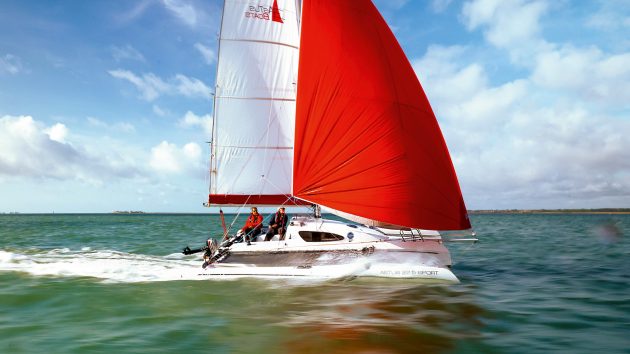
Blasting about on a sporty trimaran is a whole world of fun, but is much calmer than it looks
Trimaran sail trim
One of the biggest differences between a cruising monohull and a multihull is how the mainsail is trimmed. Leech tension on a yacht is often largely controlled by the kicker and the backstay, while the mainsheet sheets the mainsail in and out, predominantly controlling the angle of the boom to the centreline, and there may be a short traveller.
On a mulithull, however, there’s more than enough space for a good, wide traveller. Those who sail on performance monohulls will also be used to this. The sail shape is mainly controlled by the mainsheet, and the traveller then moves the boom towards or away from the centreline.
This is exaggerated on a multihull which has wide shrouds, swept well aft with no backstay, making space for a powerful square-top mainsail with full-length battens. There’s no backstay to bend the mast and flatten what is anyway a pretty rigid mainsail.
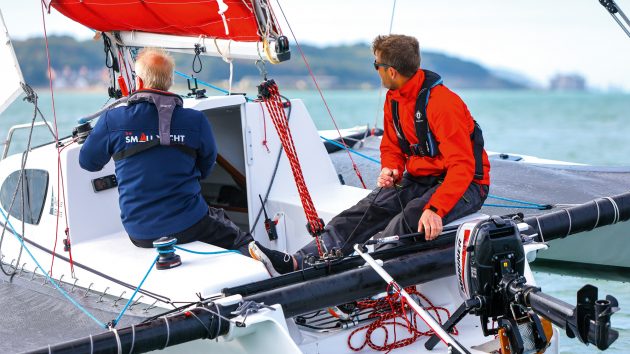
The mainsheet purchase creates enough power to control the leech of the square-top mainsail
Depowering a trimaran
Sailing on a monohull, heel and weatherhelm and eventually a broach give loads of warning that you’re pushing too hard. With straight hulls and little heel, those warning signs don’t really apply to multihulls.
In reality, however, there are a host of warning signals that it’s time to back-off; they’re just a bit different. Even then, there’s still a large safety margin before you get close to danger.
By way of reassurance, with the boat powered up on a beat, Hein, from Boats on Wheels, the boat’s owner, stood on the leeward hull and lent on the shrouds. Even as his feet got wet and the wind gusted at the top of Force 4, the boat didn’t bat an eyelid, thanks to the huge buoyancy of the floats.
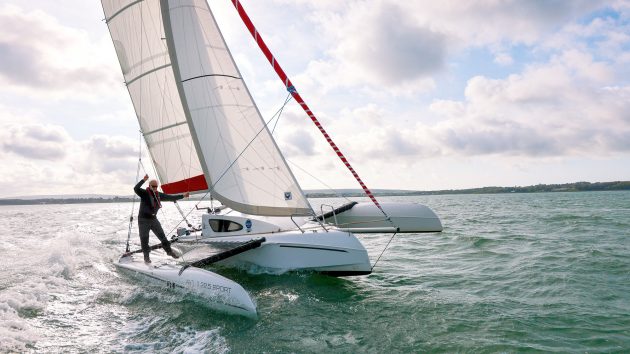
Even with a person on the leeward float the boat was extremely stable
On the water – sail trim
My first inclination was to point the boat as high upwind as possible, pin the sails in and go for height. Doing that resulted in a not-terrible boat speed of 5-6 knots and a good pointing angle.
Free off by a handful of degrees however, and ease the sails just a smidge, and the speed leapt up to 8-9 knots – over 50% more; a huge increase. So, don’t pinch. If you had a decent chartplotter on board, you could find your optimum speed to angle using velocity made good (VMG).
I was also tempted to pinch in the gusts, but it’s better to hold your course and let the speed increase until the main needs easing.
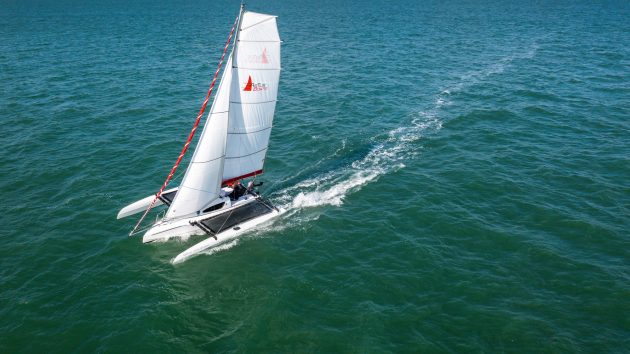
On the wind, it’s time to get the boat fully powered up
If that’s the case, drop the main down the traveller an inch or two or ease some twist into the mainsail and it makes all the difference in the world, but not so far that the top battens fall away and invert – that really isn’t fast. Push too hard and the boat will slow down, largely from the drag of submerging the leeward float and crossbeams. If you’re still overpowered and the main is luffing, it’s time to reef. Downwind is different, but we’ll get onto that later.
After we put a reef in the main, our boat speeds upwind remained largely the same, and the boat was much happier. I came away feeling reassured that even a little trimaran like this would be pretty difficult to capsize, and there were always plenty of warning signs telling me to take my foot off the pedal a little.
Article continues below…

Catamaran sailing skills: Mooring and anchoring a multihull
How do you make an average passage speed of 7 knots, fit in three double cabins and a huge saloon…

Monohull or multihull: which is best for blue water?
As former editor of Yachting World, David Glenn has plenty of experience of both monohull and multihull cruising. Here he…
Tacking and gybing a trimaran
Everyone knows that multihulls don’t tack as well as monohulls. Straight hulls and wide beam don’t lend themselves to turning, especially when coupled with the displacement and fixed keels of big cats. Trimarans are a little easier, with a single central daggerboard to act as a pivot, and one or other of the floats will generally be clear of the water. On the downside, light displacement means that there isn’t much momentum to keep you going through the turn and plenty of windage to stop you.
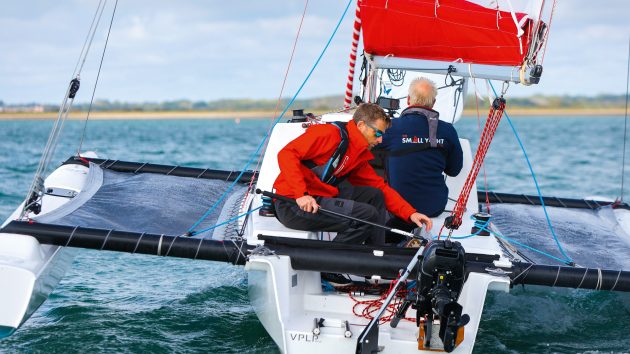
On a trimaran the central daggerboard helps the boat to turn by providing a central pivot point that catamarans lack
Speed is your friend. Build speed up before the tack to give you as much momentum as possible. The helm needs to steer positively into and through the turn, and if necessary, keep the jib backed on the new windward side to help the bow through the wind. Don’t worry about scrubbing speed off, but you don’t want to get stuck in irons.
When it comes to gybing, speed is again key. The turning bit isn’t going to be an issue as you’ll be scooting along, but the faster you’re going, the less load there will be on the sails. The more you slow down, the more the true wind will pile up.
Trimaran sailing skills
Tacks took a bit of practice. It felt plain wrong to jab the tiller across the boat, slamming a big break on in the water but I ended up putting us through the tacks far too slowly, losing a lot of speed. A more aggressive approach worked better. On the Astus, the traveller was between me and the tiller, so the tiller extension needed to be swung around the stern behind the mainsheet onto the new side.
Similarly, old habits of controlling a gybe needed to be modified. With the asymmetric set, we were planing at well over 10 knots, and the ideal is to stay on the plane. Heading dead downwind and centring the main lead to a more violent manoeuvre than flying into the gybe as fast as possible and, as the boom was never that far out thanks to the apparent wind angle, it didn’t need much extra controlling.
Coming up onto the wind after the gybe helped the asymmetric around the front of the jib and to fill on the new side. Stay too deep and it’ll get blanketed by the main. Once we had built up some apparent wind, we could bear away again.
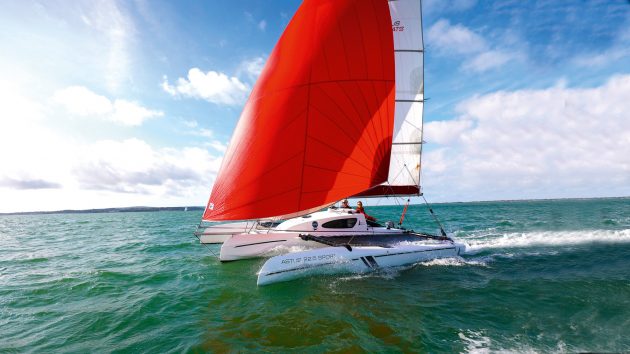
You’ll be on a course deep downwind before you know it, hitting speeds in the double digits
Downwind in a trimaran
Upwind cruising may be fun in a multihull, but bearing away and going with the wind is what it’s all about. Easily-driven hulls, a generous sailplan and light weight mean you can be up and planing, leaving displacement boats wallowing in your wake.
The big difference comes from apparent wind. If you’re in a boat that can do 15 knots downwind in 20 knots of true wind, the resulting wind angles can really mess with your head.
To get going then, says Brian Thompson, ‘Use those leech tell-tales again when sailing downwind and reaching to set the correct twist through the mainsheet, and use the traveller to set the correct angle of the whole sail to the wind.’
As the wind and your speed builds, bear away and trim the main accordingly.
In theory, you shouldn’t need to ease the traveller at all, but you may need to if you want to sail deep downwind. As the gust fades, you’ll find the boat slows down, so you can come back up towards the wind a little to pick up some more breeze, and then bear away as you accelerate again.

Bear away as the boat accelerates. Your course will be something of a slalom as you look to keep a consistent wind angle
This results in something of a ‘slalom’ course, and will also be accentuated if you’re sailing down waves, but that’s all quite normal for apparent wind sailing. Ultimately, you’re looking for a consistent apparent wind angle, even if the resulting wake isn’t straight.
It’s worth remembering that apparent wind reduces the felt effect of the wind, so you need a sailplan to suit the true, not apparent wind speed.
I found that the boat was more sensitive to having a balanced sailplan and trim downwind than upwind, largely because you’ve got almost double the canvas up, with the bowsprit as an extra lever. When weather helm built, I needed to ease the mainsheet to increase twist to depower so that I could bear away. I must admit, getting the boat balanced, sailing fast and light on the helm at 15 knots was something I came away feeling I needed more practice at.
Reviewing the images, I suspect the asymmetric was sheeted in too hard, with too much twist in the main.
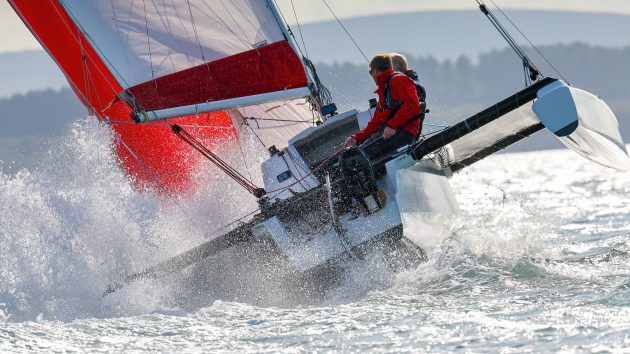
Getting a float fully submerged is when it’s time to back off
On the water
Unfurling the gennaker worked best on a beam reach, giving plenty of airflow over the sail to help it fully unfurl. This was also roughly the fastest point of sail, ideal for getting up some speed for apparent wind sailing. We mostly had the sails set for a close reach, even when we were beyond 120º off the true wind on a broad reach.
It was possible to soak deeper downwind, but lose the apparent wind benefit downwind and our speed dropped off dramatically, prompting us to point a bit higher to find some more speed.
As the boat powered up, it paid to hold a slightly higher angle than I would have done in a monohull for the boat to properly take off and get up into double digit speeds – topping out at 15 knots. Lymington to Cowes would have taken us just half an hour at that speed. It’s easy to give yourself a heck of a beat back!
We were sailing on a pretty flat day, so didn’t have to contend with any waves to speak of. On the recent RTI this is what caused the capsizes of at least two multis, a sobering reminder that you need to sail much more conservatively in lumpier conditions.
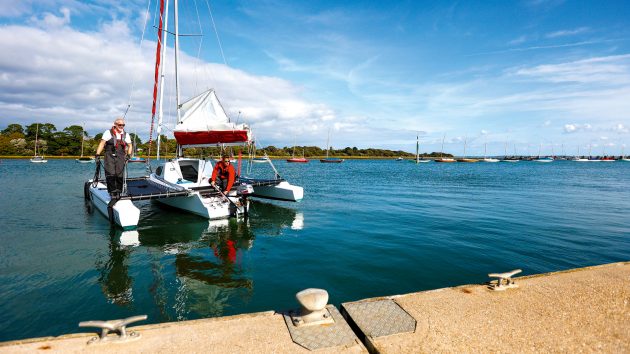
The bows want to point downwind, so a stern-first approach works with rather than against the boat
Coming alongside
A 650kg boat with no draught and plenty of windage feels dreadfully skittish when manoeuvring in confined spaces. Straight hulls with no forgiving curves and fragile-looking sharp bows make berthing tricky. You’ve got a couple of advantages on your side, however. In the Astus, the floats are at pontoon height making stepping off easy.
Whether you have an engine in each hull of a cat, or one in the central hull of a tri, there’s also a lot more leverage to play with to turn the boat and drive her on or off the pontoon. A steerable outboard gives you even more options.
If the boat has a lifting keel or daggerboards, put them down if there’s enough depth to give you a pivot and to resist drifting. Think about getting corners onto the pontoon, rather than putting the boat alongside. On tris, you won’t be able to get to the bow to fend off as it’s too narrow. You can rig a fender up forwards on a line, and two fenders are enough on the flat sides.
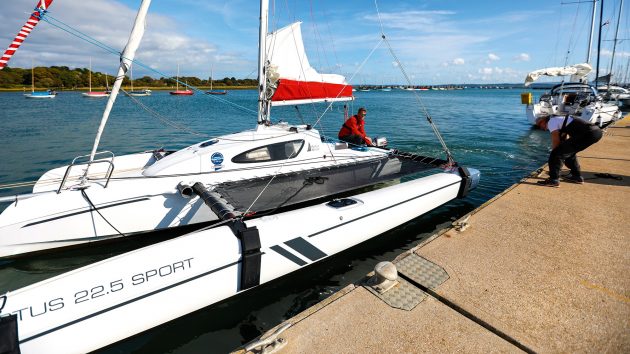
Steering with the outboard towards the pontoon will drive the stern in more; steer away to drive the bow in more
Offshore wind
Coming onto the pontoon with wind blowing off, it worked well coming in stern first. If there’s a tide running, you’ll want to be heading into the tide, so find a spot down wind and down tide to start your approach so you come in at an angle.
On our first attempt we had a bit of tide under us to start with so we came in at a much steeper angle, almost 90º, although this worked out OK in the end.
The crew could then step ashore, taking a line from the stern quarter round a cleat.
Drive forwards against the line and the bow will obediently drive up towards the pontoon, bringing you flat alongside. Getting off was simple, releasing the bowline, and allowing the bow to swing out the before slipping the stern line.
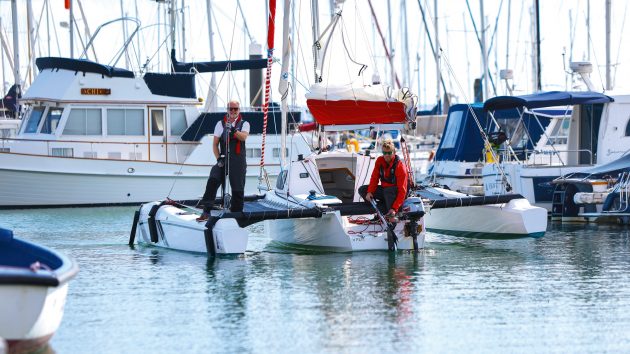
Coming in astern and stopping upwind of the berth meant the bows blew towards the pontoon far to quickly
Onshore wind
Getting onto and off a pontoon with onshore wind proved rather trickier. On our first attempt we came in stern first. The issue was that once we were just upwind of our desired berth and stopped, we lost steerage and the bow immediately blew off with alarming speed towards the pontoon.
Going ahead would only increase the force of the impact, while going astern only increased the bow’s sideways drift. I managed to back out without smashing the bow, but only just, and ended up awkwardly stern to the wind with the bows pointing at the pontoon.
On our second attempt we came in bows first but having aimed at the berth, I had to motor the stern to leeward to stop the bow hitting, making for a rather forceful coming alongside.
On take three, I came in forwards and began ferry gliding towards the berth early, keeping the bows to windward of the stern. Being able to steer with the outboard meant I could go ahead to keep the bow up, and go astern with the engine pulling the stern down toward the pontoon. In this way, it was possible to come in pretty well controlled and parallel to the berth.
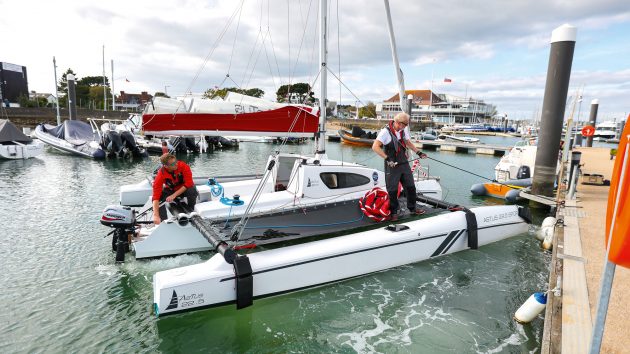
To get out, motoring astern against a bow line pulled the entire boat clear before slipping the line
Leaving was a different proposition all together, as I didn’t want to drag the bow along the pontoon, or to drive hard onto it to spring off. Instead, we rigged a slip-line from the forward cross beam. Going astern against this, and then turning the engine towards the wind, I could pull the stern, and the rest of the boat, out and away from the pontoon.
Keeping power on astern, once we’d reached a decent angle, we slipped the line and went astern, finding steerage way almost at once, with the bow following obediently in our wake with more control than I had anticipated.
Whether the wind is blowing onto, or off the pontoon, you want the engine to be driving or pulling the boat off the pontoon with a line on the corner you are going away from. That way you avoid point-loading fine ends where it’s hard to fender.
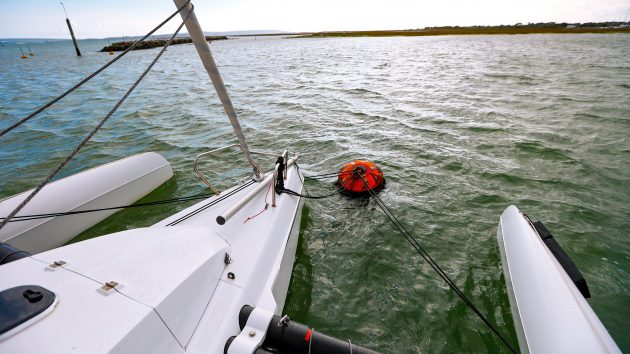
You’ll want a bridle to reduce swinging, but keep the pick up lines on the bow as backup
Anchoring and mooring a trimaran
While mooring a catamaran is complicated by the lack of a central bow, things should be simpler on a trimaran, and they are, mostly. Picking up a mooring buoy from the main hull bow with a low freeboard and dropping the pick-up line onto a cleat is easier even than a monohull.
The bow may be narrow, but for any lines that pass through a ring on the buoy, you still need to take it back to the same cleat to avoid chafe. That should be it, but windage from the two extra bows and the lack of keel mean the boat can dance merrily around the mooring buoy in a breeze.
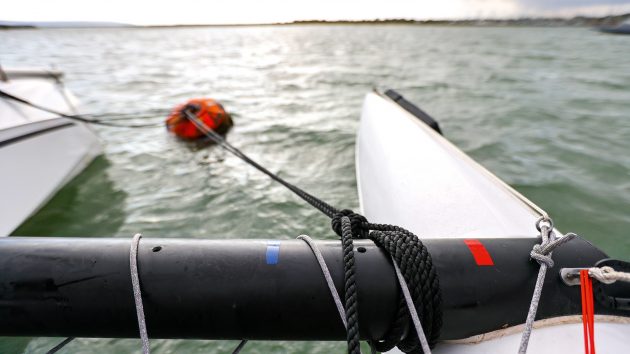
Rig the bridle so the buoy sits to one side to stabilise the boat
In practice, we found that a trimaran benefits from a mooring bridle in the same way that a catamaran does. It can’t be rigged from the floats’ bows, as there are no mooring cleats, so a line passed around the outboard ends of the forward beams gave a pretty good angle, again with long lines passed through the mooring and back to the same side. The main pick-up lines stay as a safety backup.
The other trick is to rig the bridle asymmetrically so that the buoy sits to one side or the other, just enough to not be dead head to wind, making it much more stable in the wind.
On the plus side, the lack of draught or keel means that you’ll nearly always be lying head to wind, so the cockpit remains nice and sheltered whatever the tide’s doing.
We ran out of time on the day to try anchoring, but rigging a bridle, effectively a long snubber to a point on the anchor chain in a similar way wouldn’t be tricky.
If you needed not to swing, or to behave more like deeper boats nearby, hanging a bucket over the stern can help, or there’s always anchoring with a kedge, either out ahead in a V, or in line astern.
Enjoyed reading this?
A subscription to Yachting Monthly magazine costs around 40% less than the cover price .
Print and digital editions are available through Magazines Direct – where you can also find the latest deals .
YM is packed with information to help you get the most from your time on the water.
- Take your seamanship to the next level with tips, advice and skills from our experts
- Impartial in-depth reviews of the latest yachts and equipment
- Cruising guides to help you reach those dream destinations
Follow us on Facebook , Twitter and Instagram.
Yachting World
- Digital Edition


Neel 52 trimaran review
- Rupert Holmes
- December 22, 2023
Neel broke ground with its cruising trimarans a decade ago. So what’s changed with its new 50+ footer, the Neel 52?

Product Overview
Price as reviewed:.
We’re beating out of the approach channel to La Rochelle in 8-10 knots of true wind, with some tacks as short as 90 seconds. The yacht is tacking cleanly and accelerating willingly afterwards, underlining how manoeuvrable it can be in skilled hands. Yet this isn’t a lightweight monohull – it’s a 52ft semi flybridge multihull weighing more than 13 tonnes, the Neel 52.
The first generation of Neel trimarans, including the Neel 51 launched in 2017, set a new standard in combining handling that echoes that of a monohull with accommodation of a scale that can only be found on a multihull. The concept of the Neel 52 remains the same, using the hulls of a fast racing trimaran with narrow waterline beam, as a platform for expansive four- to six-cabin accommodation.
On paper there’s no significant difference in the key dimensions of each boat, but that conceals a number of important changes. An example for this market is a much improved owners’ cabin which now occupies part of the bridgedeck and can also include the entire starboard ama.
There’s also a big difference in how the new boat handles. Offshore racing multihulls are designed to optimise straight line speed, but that’s rarely the key priority for cruising yachts. As a result the shape of the main hulls and amas of this new Lombard design are very different to those of the Joubert-Nivel-designed Neel 51 it replaces (42 built).
In particular the forward sections have a very shallow forefoot compared to the old model, where maximum waterline length was a key priority. The change improves manoeuvrability and is an important factor behind the ease with which our boat tacked in the conditions we experienced for our test. The Neel 52 is also lighter, with improved balance thanks to a mast (and engine room) further aft and a larger jib.

Most sail handling operations, except using spinnakers and furling the headsails, can be carried out single-handedly from the helm station. Photo: Rupert Holmes
On the helm
Close-hauled in more open water, with the true breeze still predominately between 8-10 knots, we consistently made just over seven knots of boat speed at a true wind angle of 60°-65°. In these conditions there’s very little heel – just enough for the windward ama to skim above the water and markedly reduce wetted surface area.
Steering is via Dyneema cables, which gives a more direct response than many alternatives, though the boat’s heavier on the helm than a well set up monohull, with a less precise feel. Nevertheless it’s still good by the standards of many cruising catamarans.
The standard Neel 52 sail plan includes a square top mainsail, slightly overlapping headsail of around 120% and staysail. Our test boat also had a very flexible 150m2 furling gennaker that can be used for reaching in 10 knots of true wind or less and broad-reaching in winds well above 20 knots. Neel also offers a larger asymmetric spinnaker as an option, as well as a marginally taller carbon rig with higher-spec Hydranet sails.
All lines, except spinnaker sheets and furling lines, are led to three electric winches at the helm station. Separate luff and leech pennants for all three mainsail reefs help tame the sail quickly. There is, however, lots of rope in this area and insufficient rope bins to handle it.

The flexible gennaker on our test boat can be used for reaching in up to 10 knots of wind and at 140° TWA in well over 20 knots
Downwind and reaching sails sheet to the back of the amas, while genoa and staysail furling lines are led to the aft end of the starboard ama. This arrangement for the furling lines greatly reduces friction compared to the convoluted route they would have to take to lead to the helm station, but means furling these sails isn’t an easy single-person operation.
With the true wind building to 10-11 knots and puffs to 13 we consistently made speeds of around 9 knots, with occasional bursts just into double figures when reaching at 110°-120° TWA, with the gennaker and staysail set. This was easy sailing at speeds that will quickly gobble up the miles when on passage.
Visibility from the Neel 52 helm station is excellent on port tack, but there’s a big blind spot on starboard – you need to descend four steps to see under the jib or gennaker. A semi flybridge above the hard top, with space for up to eight people, includes generous sunbeds. This is right next to the helm/winch station, so communication between the two is easy and, unlike many multihulls, it doesn’t feel as though the helmsman is isolated from everyone else on board.
You have to be sure guests are sitting before tacks and gybes, when hoisting and dousing the mainsail, and when reefing on port tack. There’s a bimini for sunshade over the helm area, with a clear overhead panel for sail trim, but no provision for sun protection over the flybridge area, though the hardtop over the main aft cockpit gives plenty of shade.
A key selling point for Neel is offering a very refreshing change to the familiar layouts of cruising multihulls of similar length, and the Neel 52’s arrangement feels generally bright, welcoming and innovative.

The saloon adjoins the cockpit, however you need to stoop to see out of forward windows. Master cabin is to starboard but you need to draw blinds for privacy
Neel 52 – bridgedeck cabin
The older Neel 51 benefitted from Neel’s trademark bridgedeck level cabin, which gives a fantastic view out almost all round the boat when you wake up. This comes at the expense of some privacy, though, which is largely solved by closing the window blinds in the bulkhead that separates the cabin from the saloon. But this space was small compared to typical catamarans owners’ cabins.
Owners with guests will still need to close the blinds on the main bridgedeck cabin on the Neel 52, but this now links to the whole of the starboard ama. This is a private area with a desk/dressing table and a generous amount of stowage in hanging and shelved lockers. Ventilation is provided by several overhead hatches and there’s a long hull window above the desk which provides plenty of natural light.
The mid part of the owner’s ama has a heads with a separate shower stall, while further forward is an additional space that was left fairly open in our test boat, with the exception of a washer/dryer. This area has obvious potential for much more stowage, or even a workbench.

Large and well appointed galley.
The aft cockpit under the hardtop is relatively small, but this doesn’t feel important since this space fully opens up onto an expansive saloon, with the interior and exterior tables together forming a dining table that can be extended almost seamlessly to just over 3m in length.
Ahead of the saloon area is a large navstation with a double seat and a good view forward, to port and aft. However, the bridgedeck owner’s cabin creates a large blind spot on the starboard quarter and there is no hatch above to view the mainsail.
All layout options have a large and well equipped galley forward on the starboard side of the saloon. There’s acres of worktop space, a four-burner gas hob plus oven, large refrigeration and freezer capacity, plus a slimline dishwasher. Stowage is in 17 lockers both under the counter and at eye level. The saloon has two opening panels in the front windscreen for natural ventilation, plus a small opening hatch over the cooker.
In four-cabin boats steps lead down to a double cabin in the port ama, with a large double berth aft, above which is a long hull window that gives a great view out. Stowage here is primarily in a small hanging locker, plus empty space under the berth that can be used for easy access to kit bags. Forward of this are heads and shower compartments mirroring those of the starboard ama, and further forward a space similar to that with the washing machine on the starboard side.

Bridgedeck level owner’s cabin.
Alternatively the port ama can be fitted out as two doubles that share a central head/shower compartment. This option is also available in the starboard ama for six-cabin charter specification boats. These also gain additional saloon and dining space on the bridgedeck as there’s no owner’s cabin at that level.
Seven steps at the front of the saloon descend into a further double cabin in the centre of the main hull, under the solid bridge deck. There’s plenty of space, but natural light and ventilation are restricted, with the former coming solely from the two escape hatches. There’s stowage plus a heads compartment (without shower) shared with a forward cabin at the front of the main hull.
On the test Neel 52 this is fitted out as a Pullman-style cabin with bunkbeds. Crew cabins, each with a single berth and head/shower, can also be specified at the aft end of each ama.

Owner’s hull space in starboard ama
On the downside, some elements of the interior have hard edges in places that may not wear as well as rounded corners. And traditionalists won’t be impressed by the inside of lockers which have a similar feel to mass market home furniture.
Neel’s trademark full height technical area with engine and systems is restricted to the back of this model. Nevertheless, it remains a well laid out and useful space that will make maintenance and repair easier than on many yachts. Unlike cruising catamarans, Neels have only a single engine in the main hull, so a bow thruster is fitted as standard. A stern thruster is offered as an option that can make Mediterranean-style mooring a lot easier.
Deck stowage includes large lockers that can accommodate sails, fenders and watersports toys, while the tender rests on purpose made chocks at the aft end of the main hull. It’s lifted using a line from the end of the boom – a simple arrangement that avoids the weight, complication and cost of davits. Access to the water is from the extended bathing platforms on the aft end of each ama and the transom of the main hull.
Our test Neel 52 was set up with just under 2kW of solar panels on the coachroof. Neel says this is almost enough for complete autonomy while cruising when combined with the boat’s lithium iron phosphate battery bank, though as standard 625Ah of 12V AGM batteries are fitted.
If you enjoyed this….
Yachting World is the world’s leading magazine for bluewater cruisers and offshore sailors. Every month we have inspirational adventures and practical features to help you realise your sailing dreams. Build your knowledge with a subscription delivered to your door. See our latest offers and save at least 30% off the cover price.
There’s much to like about this boat for anyone who needs the accommodation volume offered, or is seduced by the appeal of Manhattan-style loft living. The Neel 52 also offers a big advantage over its predecessor thanks to the reconfigured owner’s suite with immensely more space. Speeds under sail are unlikely to differ noticeably to the 51, which already had potential for very quick passages when reaching, although upwind and downwind VMG for both models is less impressive, other than downwind in a blow. However, the way the new boat behaves under sail gives it a feel closer to that of a cruising monohull. More importantly for this part of the market, the 52 is easy to handle, with few operations requiring more than one person on deck. These factors, combined with the various layout options, boost this yacht’s appeal and by the time the prototype had been in commission for three weeks, delivery schedules were already stretching into early 2026, with 26 boats sold.

- Wētā in Action
- Where to Buy
- Owners Locker
- News & Events
- Wētā Owners
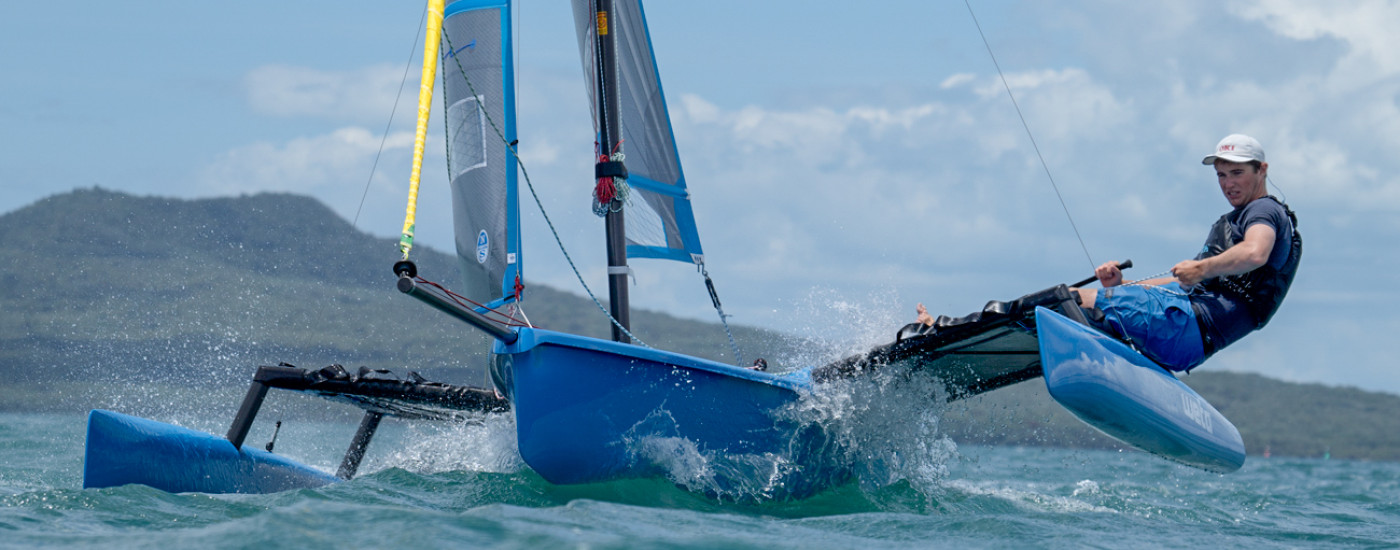
Fun. Fast. Easy.
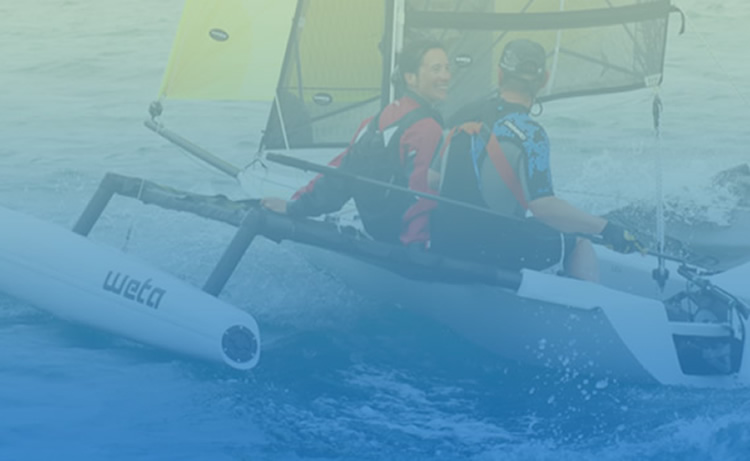
A robust and versatile trimaran.
Latest News & Events
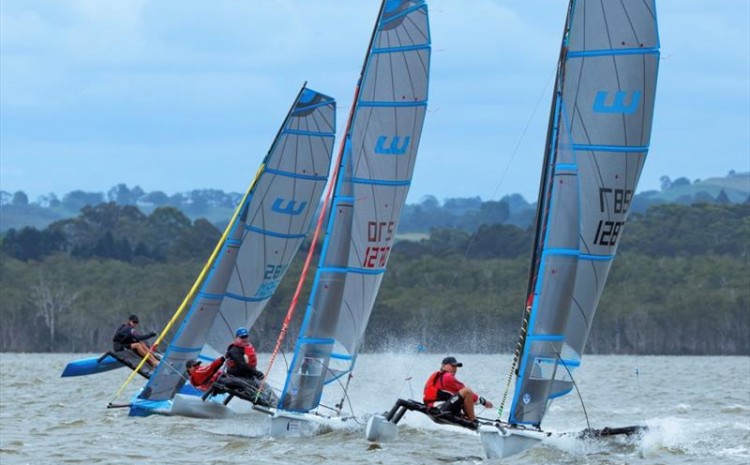
Wētā Worldwide
See where our boats are all over the world

Stay Connected to Wētā
Get the latest news, product updates and much more.
CORSAIR 760
The 24' corsair has been an enormous success across more than 3 decades of production. however this newest model has received a radical redesign by our partners at perus yacht design, making her the best 24' corsair yet., complete control & comfort, in such a performance machine.
“ Some of the best sailing I’ve done in my entire life and I’m very new to trimaran racing or multihull racing. It’s a blast, I cannot think of anything better than sailing a Corsair trimaran”
– Donovan Brennan – USA
SLIDING POPTOP
Comfortable cruising trimaran.
The 760 offers a comfortable cruising interior with compact galley and pop top to add headroom. This compact cruising trimaran has been designed to comfortably sleep couples for a weekend getaways. With the addition of an optional collapsible dining table, it will sleep up to 4 making the 760 a performance cruiser the whole family can enjoy.
COMPACT GALLEY
More comfort and safety than any other trimaran of this size, and the greatest 24’ Corsair yet. This is a beautiful new Corsair offers a comfortable new cruising interior to sleep a couple on a weekend getaway with a galley sink and stove to keep you refreshed.
The 760 offers a comfortable cruising interior with compact galley and pop top. This compact cruising trimaran has been designed to comfortably sleep couples for weekend getaways and with the addition of an optional collapsible dining table will sleep up to 4 making the 760 a performance cruiser the whole family can enjoy.
FOLDABLE PERFOMANCE CRUISER
FOLDABLE PERFOMANCE CRUISER Being able to easily fold and quickly trailer is an important feature for all Corsair trimarans and is a feature that makes the 760 a great choice for people looking to get out on the water and have fun with minimal effort.
FOLDABLE PERFOMANCE CRUISER Folding and unfolding a Corsair takes only a minute. With just 4 bolts to remove, it is easily managed by one person, and is normally done while afloat.
FOLDABLE PERFOMANCE CRUISER The 760 offers a comfortable cruising interior with compact galley and pop top. This compact cruising trimaran has been designed to comfortably sleep couples for weekend getaways and with the addition of an optional collapsible dining table will sleep up to 4 making the 760 a performance cruiser the whole family can enjoy.
FOLDABLE PERFOMANCE CRUISER The 760 offers sailors more comfort, performance and safety than any other trimaran range in this size. This has been achieved by cleverly designing high volume, wave piercing floats. Offering additional buoyancy and significantly increasing the vessels righting moments and safety margins.
Ideal boat for a Solo Adventure:
Sailing the corsair 760.
We go on a SOLO adventure onboard the thrilling Corsair 760 to remote national parks to see all design features of this ultra versatile boat and discover that you don't always need a crew or a big boat to enjoy cruising.
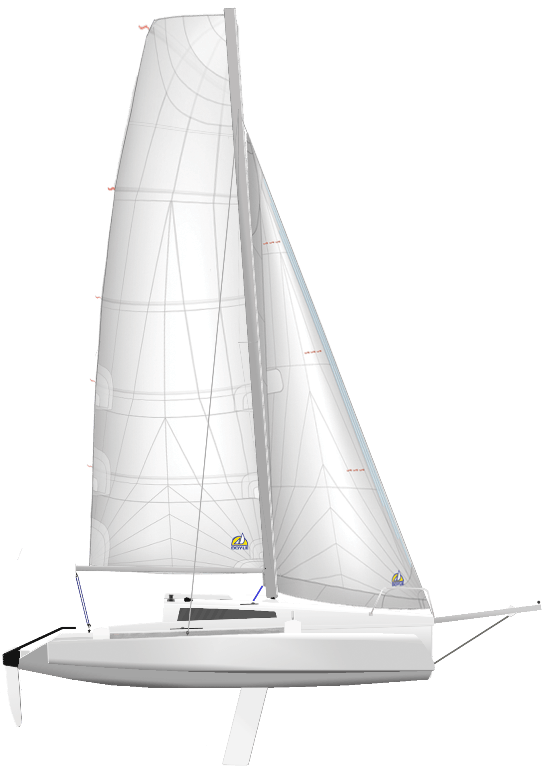
SPECIFICATIONS
Overall length, 24' 3" / 7.39 m, 17' 11" / 5.46 m, beam folded, 8' 2" / 2.5 m, upwind sail area, draft d/b up, draft d/b down, 5' 3" / 1.6 m, mast length, 34' 5" / 10.5 m, unladen weight, 2,094 lbs / 950 kg, 34' 5" / 10.5 m carbon, 1,795 lbs / 816 kg, recommended options.
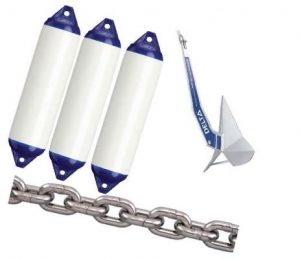
Dash760-OPT006
Anchor, chain & fenders.
The option will include:
- Anchor & rode.
- 3 x high quality fenders.
- 2 x mooring lines.
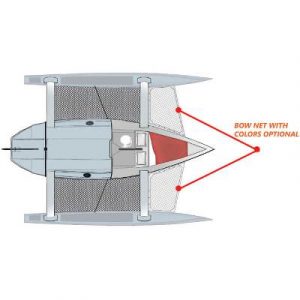
Dash760-OPT003
Sunrise yachting high-quality reinforced bow nets increase the safety and comfort of your boat.

DASH760-OPT001
Floats locker.
Upgrading this option allows you to easily access and utilise the space inside the floats – often for storage of fenders, ropes, hooks, and more… This option also will change the standard 6′ hatchs to 2 high quality tempered glass covers.
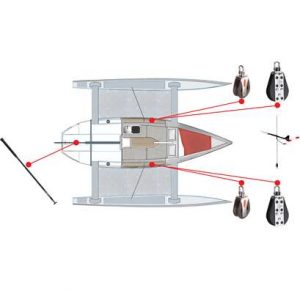
PERFORMANCE PACKAGE
This option will enhance your fine control over the performance of the boat. The option includes:
- Ronstan Battle stick
- Windex 15 wind indicator
- 2 Harken & 2 Ronstan blocks
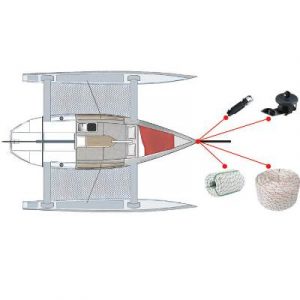
SCREACHER CONTROL KIT
Screacher control kit for Corsair Dash 760 and 760R. This is a required option if you would like to include a screacher sail with your boat, or would like to add such a sail in the future.
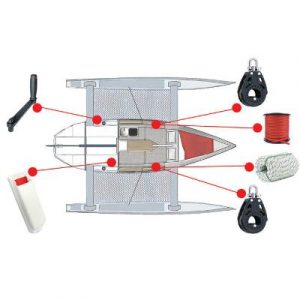
SPINNAKER CONTROL KIT
- Double braid ropes
- Winch pocket & winch handle
- 2 Single 57mm carbo block
- Folding Corsair Trimarans: Legendary Ability, Unbeatable Reliability
- 5 Reasons Why The Corsair 760 Trimaran Won Multihull Of The Year
- Corsair Range Brochure
- Corsair Community
- Find A Dealer

Tel +84 28 3873 3630
Sales Enquiry:
Customer Service Enquiry:
© 2024 Corsair Marine International. Alls rights reserved.
Privacy Policy

Your sailing multihull DESIGN-INFO site for…
Small trimaran information, small multihull design, design issues, construction methods, comparisons of designs, speed, stability, and much more….

W17 Main Page
—Chris, Queensland
—Andrew, Philippines
—Jonathan, Michigan
—JR, first W17 kit owner
—Alan, St-Jean-de-Luz, France
—Louis & Luigi, Philippines
—David, Philippines
…I'm very impressed with the seaworthiness of this little boat. I have been in places I clearly should not have been, and in some very bad weather too…
—Andrew, Philippines
Read more sailors' comments…
…was immediately struck that Mike's design goals closely matched my own. Really liked the look of the curved akas and plans for a wing mast are a big plus.
—Gary, Virginia
Read more builders' comments…
This boat…has such style and lines that she'd look totally in place as a sporty tender or toy on the deck of a fine Italian mega yacht. Very nice indeed!
—Marshall, Florida
—Don, Alberta
" ... the W17 feels like it's flying through the water and air, unlike any other sailboat I've ever been on .... as it slips over the water with such agility and efficiency
—Bill, W.Virginia
‘The Waters Edge’
W22 main page.

- Performance
- Construction
- NEEL 43 PERFORMANCE limited edition
- Rental-Management
- Charter a NEEL trimaran
- LEEN-TRIMARANS
- NEEL-TRIMARANS GROUP
- NEEL OWNERS COMMUNITY
NEEL-TRIMARANS

Design and performance
Neel trimarans are unique sailing boats that brilliantly combine unequalled comfort on board and incredible sailing pleasure. a good balance due to the experience, know-how and skills of a team of passionate people..

Try to win a cruise on a NEEL 43 on our Instragram!

A NEEL trimaran, the perfect sailing boat for an unforgettable adventure

NEEL-TRIMARANS and its dealer network are organising the PRIVATE DAYS in La Rochelle from March 2, to March 4, 2023
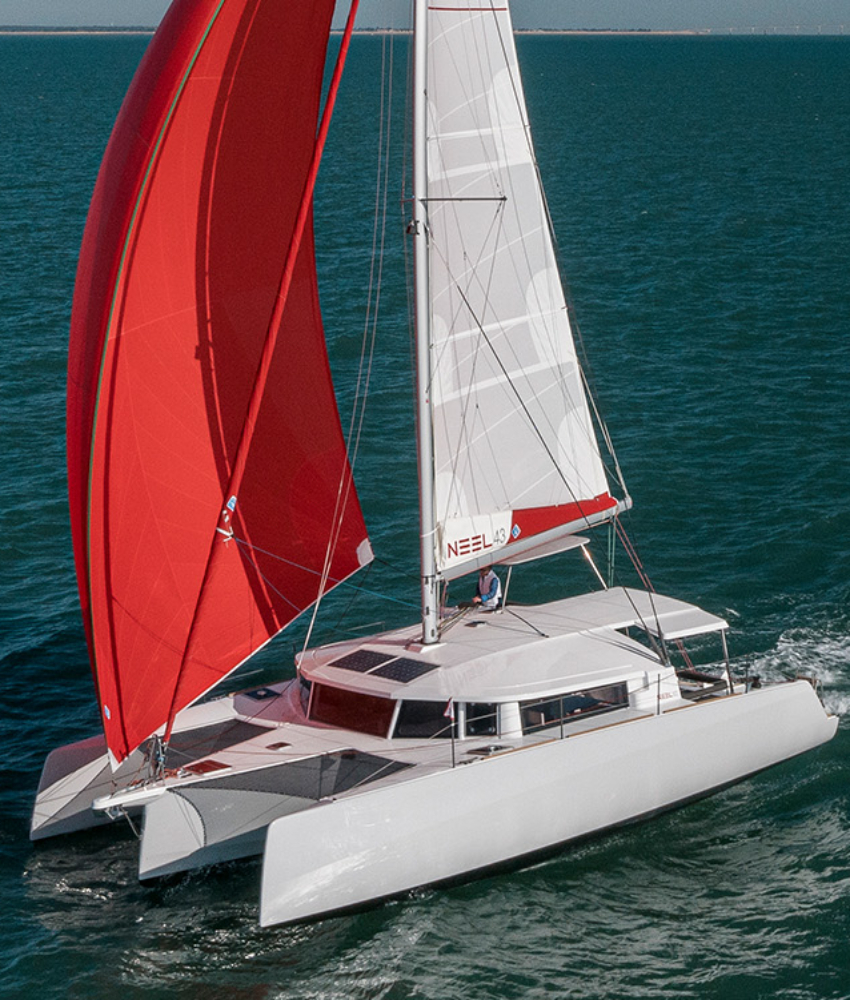
NEEL 43 elected among the top 10 boats of 2023 by SAIL Magazine
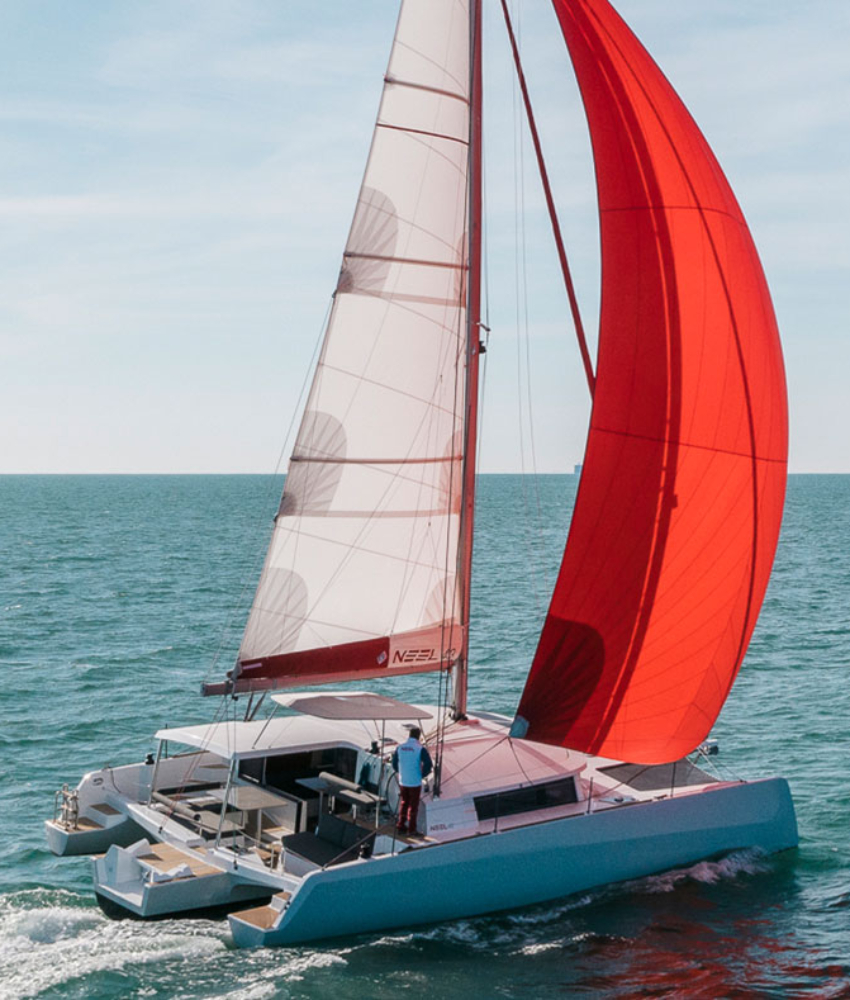
NEEL 43 nominated for two prestigious American awards

The latest Lombard-designed addition to the range is even more innovative and impressive, and with a marked move towards the use of bio-sourced and recyclable materials. The NEEL 43 is available in a limited edition performance version.
The neel 47 successfully combines the benefits of cruising or blue water yacht : safety, performance and comfort living..
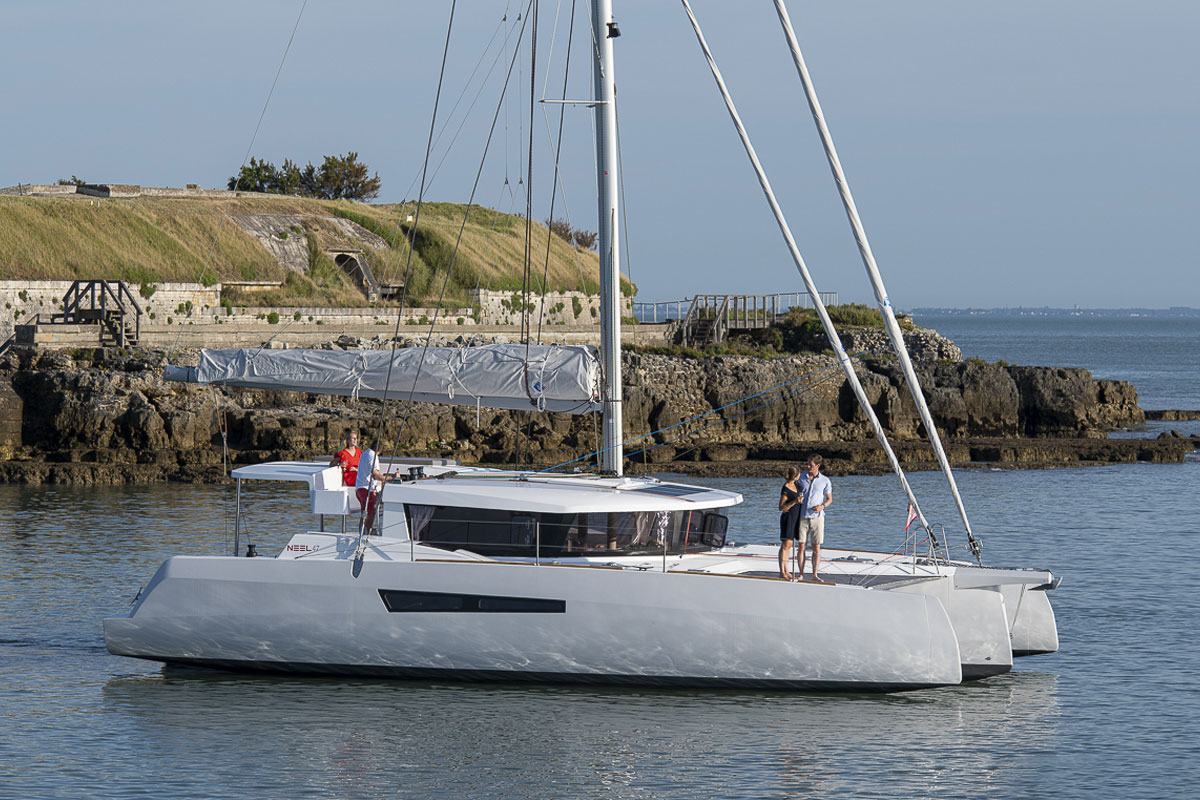
With its racy, modern silhouette, elaborately designed hull and sleek lines, the NEEL 52 exudes power, speed, and elegance. Moving inside and on the deck is smooth and safe.
The neel 65 evolution, the flagship of the fleet, offers unequalled comfort and navigation in "sport-chic" mode..

Privacy Overview
- Legal Notice
- Recruitment
- Private access

Sailing La Vagabonde choose Rapido 60 to sail world’s oceans
June 08, 2021
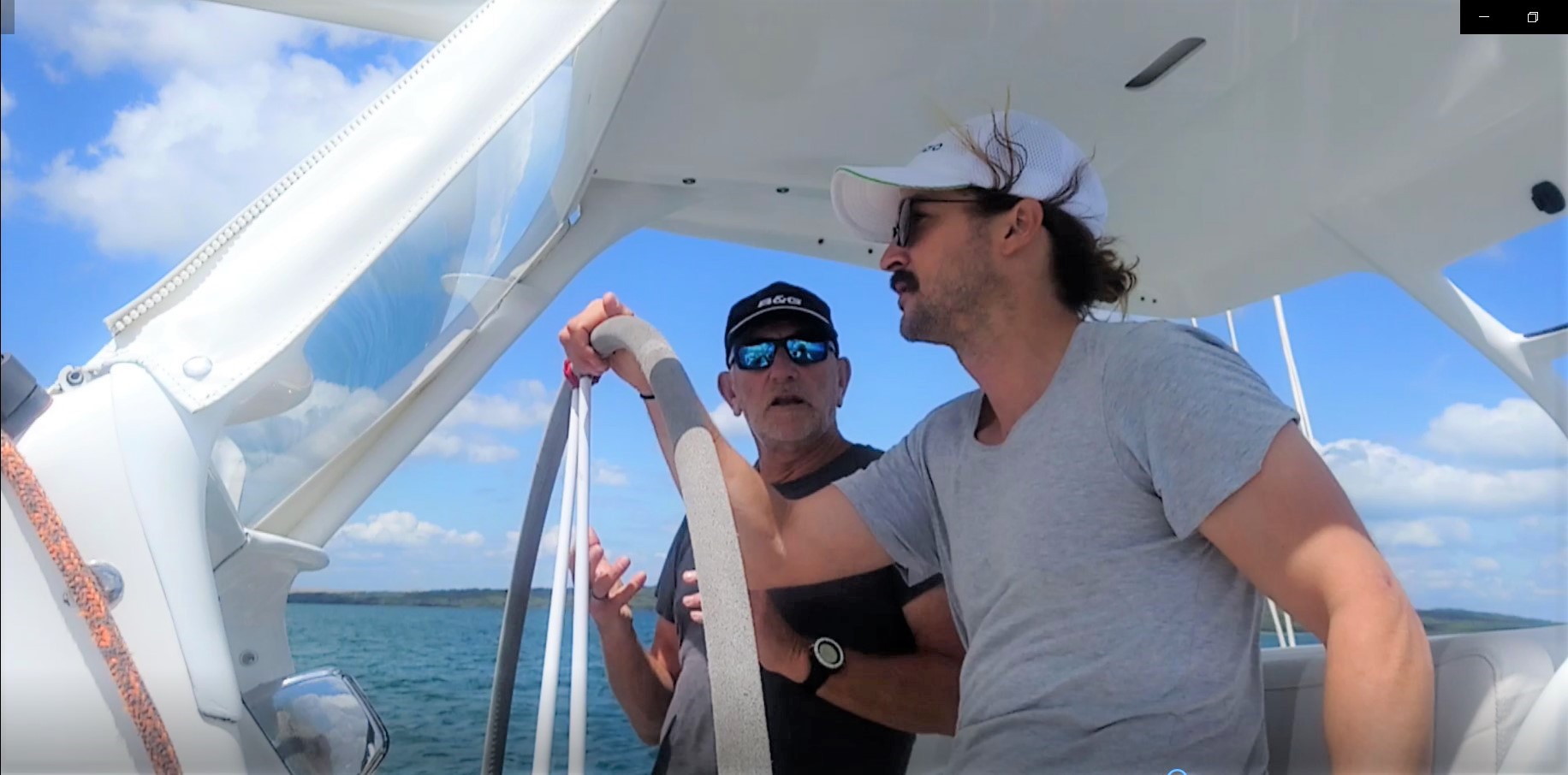
Rapido Trimarans is thrilled to confirm that Sailing La Vagabonde (SLV) will sail the world’s oceans aboard a Rapido 60!
In fact, SLV’s video announcing the decision to their 1.59 million subscribers (yes, 1.59m subscribers!) will go live live at 8.30am, Adelaide time in Australia (GMT/UTC +9:30) on 8 June 2021.
See the SLV video embedded below.
Welcome Riley, Elayna, Lenny +1 to the Rapido family!!! It is so good to have you on board!

Who is Sailing La Vagabonde?
SLV comprises an Australian couple, Riley Whitelum and Elayna Carausu and their son, Lenny. Additionally – and literally – joining the team will be their new-born, any day from now!
Riley and Elayna’s job is to sail the world’s oceans and, each week, bring their adventures to our phones, desktops and iPads via You Tube.
They began documenting their evolving journey on You Tube back in 2014 with a single-hull vessel. After a time, they upgraded to a twin-hulled vessel and, for the last 18-24 months, have been researching which boat would become the future of their sailing story, and proudly wear the title Sailing La Vagabonde III .
As part of their exhaustive selection process, they travelled to New Zealand in December 2019 for a test sail aboard the Rapido 60, Romanza . Owners of Romanza Dougall and Jaz Love were there together with co founder of Rapido Trimarans, Paul Koch. Some photos from that trip are posted below.
Eventually, falling out of Riley and Elayna’s exhaustive selection process was a three-hulled 6o’ (18m) trimaran, the Rapido 60.
Riley and Elayna explain why they chose the Rapido 60 (comments from video above)
But now, let’s hear from Riley and Elayna as to why and how the Rapido 60 met their criteria:
Riley – Rapido offers sailing performance and space
I know that the Rapido sails unbelievably well which is the main thrust behind all of our decision making.
(When we went to New Zealand), I knew it was going to sail well. I knew it was beautiful. I knew it was very well made because I’ve got a lot of respect for the boat builders.
The only thing I was worried about was the amount of space on board.
I jumped onboard ( Romanza ), ran around and I was like, “Ahhhhhh!, this is perfectly fine!” (Later in video Riley describes the forward cabin as being “massive” with a “huge” bed. “When you’re standing in the saloon, you’re actually standing in a huge room.”)
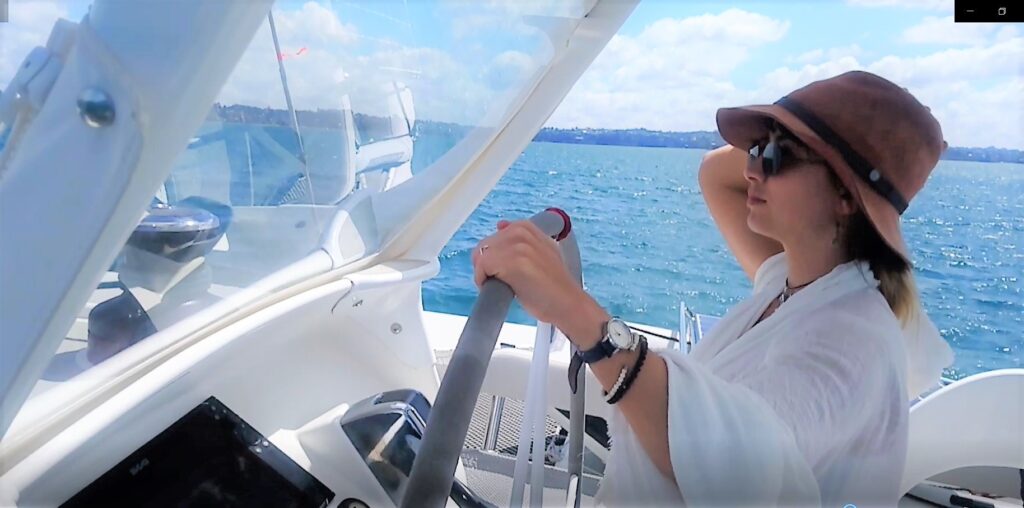
Elayna – Lightning speed at 25.7 knots
She goes at lightning speed. During the test sail, I was at the helm with one hand on the helm and we were going at 25.7 knots! I think I got the top speed for the day!
Riley – Maintaining a speed
25.7 knots – that’s extraordinarily fast. (And) that’s maintaining a speed; not surfing down waves.
Elayna – Just slightly heeling over
That was constant 25.7. In fact I think it was 26.7 but just in case, I will say 25. There you go!
It was fast and I was worried it would really heel over. (But) even at that speed, it was just slightly heeling over.
Riley – I want to be able to go at a good pace safely
I’m much more interested in average crossing times. I mean it’s good fun to go fast but that’s the least important on my list of things. I want to be able to go at a good pace safely.
It felt beyond comfortable.
When we were doing 20 knots, It felt like we were only going 10 – and it felt like we had so much more power just sitting there in reserve.
It felt like we were just ticking along and that is a nice feeling.
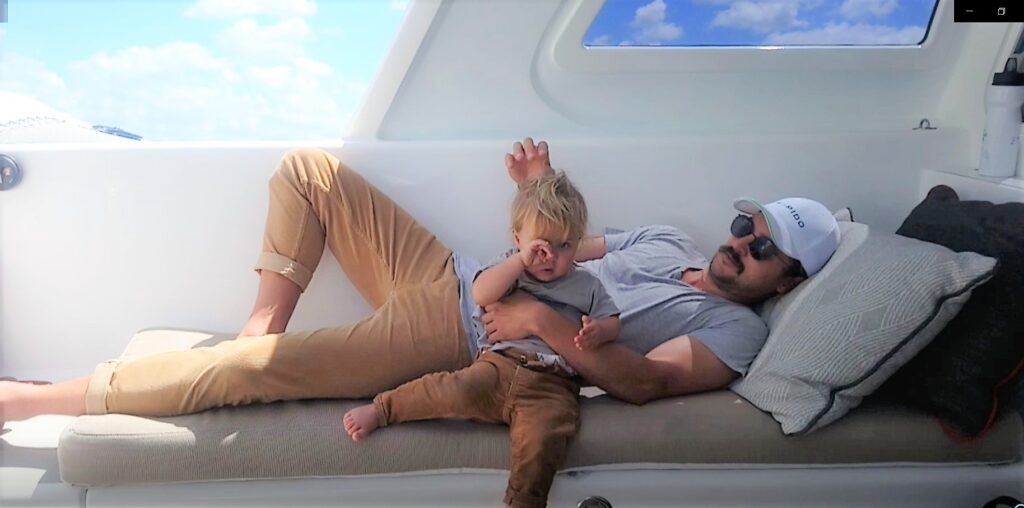
Elayna – Must be able to sail it single-handed
One thing that was really important for us with the trimaran was that Riley will have the ability to sail it single-handed because we will have two kids on the boat.
Riley – I’m not going…
I’m not going on a boat that I cannot single-hand.
Riley – Selecting a boat
In the end, it came down to what we really want to be on and what we think you guys (our viewers) want to see us sailing on.
This is so exciting.
And, I think, new.
Comment from Rapido Trimarans
As mentioned above, Rapido with Sailing La Vagabonde’s decision to explore the world on a Rapido 60, the Queen of the Oceans .
Elayna and Riley love the boat and also believe that it’s what “we think you guys (SLV’s 1.59 million viewers) want to see us sailing on”.
Dougall Love, co owner of Rapido 60, Romanza , once remarked that he believed the qualities found in the Rapido represent the “the future of sailing”.
With the extraordinary reach and exposure of Sailing La Vagabonde, perhaps the future is now a lot closer than many would have thought possible!
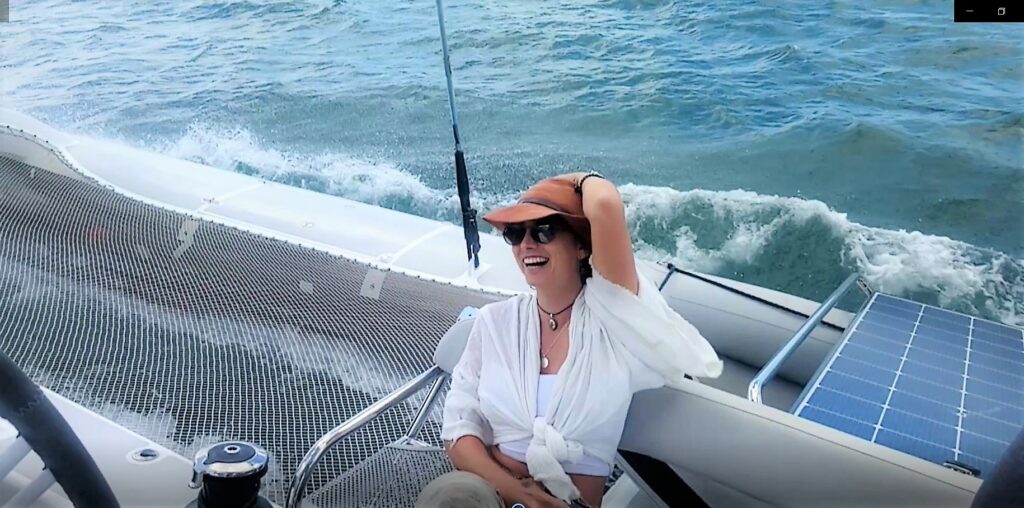
Post from the Sailing La Vagabonde website [7 June 2021]
We’re. So. Excited. We’ve been exploding waiting to tell you the massive news now that it’s official: LA VAGA III has begun.
It’s been a real labour of love to find our new home. It’s something that we’re really looking forward to and something we’re really confident we’re gonna love. We want to take you inside our new home, what it looks like…. hypothetically.
Yes, we haven’t built it yet, so this is as big a journey as ever for us. It’s clean and green, it’s a super stable and fast trimaran that we’ve always dreamed of.
As our family is getting bigger, these things have got that all-important storm-dodging speed and an insane level of stability.
The guys at rapidotrimarans.com really know what they’re doing with these beautiful boats and we’re so glad to be with them.
- If you are interested in learning more about becoming a Patreon of Sailing La Vagabonde, click here .
Video below: Riley describes his ideas of a “good and safe multihull sailing philosophy” and how to apply them when selecting a boat that is right for you.
Related websites for Sailing La Vagabonde (SLV)
- Sailing La Vagabonde explain their multihull criteria , by Toby Hodges, Yachting World, 12 February 2021 (this article was published prior to SLV announcing their decision to ‘go with Rapido’).
- SLV’s You Tube channel
- SLV’s Facebook page
- Elayna Carausu’s Instagram page
- Riley Whitelum’s Instagram page
- Rapido Trimarans’ You Tube page
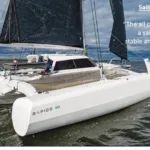
Cruising World reviews Rapido 40, a s...
Sailboat Review: Rapido 40. The all-carbon-fiber Rapido 40 trimaran...
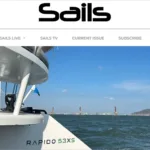
Rapido host much anticipated launch o...
Rapido Trimarans hosted the much-anticipated launch of the first Ra...
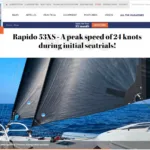
Rapido 53XS – A peak speed of 24 knot...
Rapido 53XS - A peak speed of 24 knots during initial sea trials!, ...

IMAGES
VIDEO
COMMENTS
The 2019 Weta trimaran is easy to sail and is worth considering whether you want to take a quiet sail, race with your friends, or take kids to a sailing lesson. It has a simple design and is easy to set up independently. Thanks to its collapsible design, this trimaran is easily stored away with minimal space demands.
A stainless steel bolt on the inboard end of each beam secures the floats for sailing. Crucially, wingnets remain attached during the folding process - their frictionless fixing allows them to tension themselves appropriately through the folding process. The system is so simple and balanced that Corsair trimarans can even be folded while ...
Trimaran sailing vessels for sale on YachtWorld are offered at a variety of prices from $9,574 on the lower-cost segment of yachts all the way up to $2,868,792 for the most expensive yachts. Trimaran By Condition. Used Trimaran 76 listings . New Trimaran 41 listings . Manufacturer of trimaran.
Here are 6 of the best trailerable trimaran: The Dragonfly series. F-22. Corsair Series. Astus. Weta 14.5. Windrider 17. Choosing the best trailerable trimaran (a multi-hull with three "hulls") will depend on crucial factors like speed, durability, design, and ease of transportation.
Known for their award-winning luxury trimarans, NEEL is based in La Rochelle, the capital city of sailing in France. NEEL trimarans are built for fast cruising with an average cruising speed of about 10 knots, and are even configured to facilitate that sustained speed under motor propulsion. The NEEL 45 was notably named Cruising World's Most ...
Trimaran sail trim. One of the biggest differences between a cruising monohull and a multihull is how the mainsail is trimmed. Leech tension on a yacht is often largely controlled by the kicker and the backstay, while the mainsheet sheets the mainsail in and out, predominantly controlling the angle of the boom to the centreline, and there may be a short traveller.
About Rapido. The idea behind building the world's best ocean-cruising trimarans came from the team that has built more than 1,500 production trimarans globally. The world-acclaimed Morrelli & Melvin was then tasked with developing the design and engineering for Rapido to start building! Separately, for those who think our advanced lightweight ...
US $743/mo. 180 Marine | San Francisco, California. Request Info. <. 1. 2. >. Find Trimaran boats for sale in United States. Offering the best selection of boats to choose from.
This is a beautiful new Corsair sailboat in a legendary size which offers a comfortable new cruising interior to sleep a couple and kids on a weekend getaway with a galley sink and stove. Corsair Marine has launched over 700 trimarans of this size. CORSAIR 760. CORSAIR 880. CORSAIR 970. Discover our range of trailerable and foldable trimarans ...
Suited to day sailing, family cruising, and racing, there are more than 2500 Corsair trimarans launched. We are pleased to present you with the current range of Corsair trimarans - from the 6-metre Pulse 600, to the legendary Corsair 37, and now the all-new Corsair 880, which represents the pinnacle of sailing trimaran design…
A traditional paraw double-outrigger sailboat ( bangka) from the Philippines. A trimaran (or double-outrigger) is a multihull boat that comprises a main hull and two smaller outrigger hulls (or "floats") which are attached to the main hull with lateral beams. Most modern trimarans are sailing yachts designed for recreation or racing; others are ...
The Marlin trimaran is self-sufficient in energy with a 450 W solar panel on the roof of the deckhouse, supplying power for its e-engine by torqeedo, light and other equipment on board. Last, and perhaps most importantly, is that Marlin trimaran racer-cruiser version can weight around 1.500 kg (see specifications) fully ready to sail.
00:00. 02:57. Our test Neel 52 was set up with just under 2kW of solar panels on the coachroof. Neel says this is almost enough for complete autonomy while cruising when combined with the boat's ...
This week is the start of a new multihull adventure…Trimaran Life! Have we ever sailed a trimaran? No. Have we ever been skippers of any other vessel asid...
Trimaran. Ideal for overnight cruising and day sailing these Trimaran boats vary in length from 14ft to 78ft and can carry 4 to 15 passengers. There are a wide range of Trimaran boats for sale from popular brands like Corsair, Neel and Dragonfly with 43 new and 90 used and an average price of $245,164 with boats ranging from as little as $9,846 and $2,645,738.
Stay Connected to Wētā. Get the latest news, product updates and much more. Expertly made for maximum enjoyment and minimum fuss, the Wētā is simple to sail, surprisingly quick, and an absolute ton of fun. Find out more.
Trimaran sailing vessels pricing. Trimaran sailing vessels for sale on YachtWorld are on offer across a broad price range from £9,676 on the relatively moderate end up to £3,226,192 for the most luxurious yachts. Find Trimaran boats for sale in your area & across the world on YachtWorld. Offering the best selection of boats to choose from.
The Corsair 760 is Corsair Marine's newest pocket cruiser. This new trailerable trimaran is destined to bring trailer sailing to the next level. Originating from the ever popular Corsair 24 and 750 range this new model has received a radical redesign by our partners at Perus Yacht Design.
50 knot winds in the middle of the Ocean! SAILING TRIMARANEnjoy!Ania and BartekJOIN OUR LOVE BOAT GROUP:(Extra content for our Patrons only)https://sailocean...
Small Trimarans Report. Back in 2010, sailor/naval architect Mike Waters published a 22-page report covering 20 small trimarans. It includes charts, graphs, photos, and critical objective reporting on many of them. Read more…. Review of nine Small Trimarans. Mike Waters' review of nine small folding trimarans 14-20 feet including six ...
These sailboats have a minimum total sail area of 717 square feet, a maximum total sail area of 2,077 square feet and an average of 1,397 square feet. Boat Trader currently has 10 trimaran sailboats for sale, including 1 new vessels and 9 used and custom yachts listed by both individuals and professional dealerships mainly in United States.
A NEEL trimaran, the perfect sailing boat for an unforgettable adventure. News News Uncategorized. NEEL-TRIMARANS and its dealer network are organising the PRIVATE DAYS in La Rochelle from March 2, to March 4, 2023. Awards News Uncategorized. NEEL 43 elected among the top 10 boats of 2023 by SAIL Magazine.
June 08, 2021. Rapido Trimarans is thrilled to confirm that Sailing La Vagabonde (SLV) will sail the world's oceans aboard a Rapido 60! In fact, SLV's video announcing the decision to their 1.59 million subscribers (yes, 1.59m subscribers!) will go live live at 8.30am, Adelaide time in Australia (GMT/UTC +9:30) on 8 June 2021.